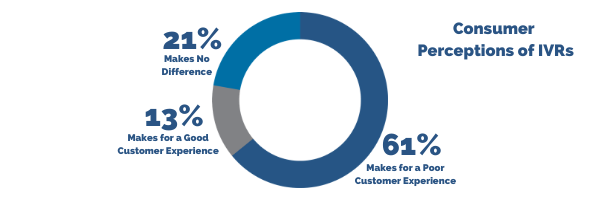

Interactive voice response or IVR is an often utilized and often misunderstood feature of advanced call centers. As a caller yourself, you have certainly experienced both the good, and unfortunately the bad of an IVR. IVRs are also known as a “virtual assistant.”
IVR is an automated, pre-recorded menu of options, services, and information that can direct callers. An IVR can lead callers to a particular department or person, read company information like operating hours and address, share situational updates, like outage updates or event info.
IVR technology has been around since 1962, giving consumers plenty of experience navigating them. Despite their pervasiveness, how do customers really feel about IVR technology, and how can you configure yours for success?
Think of the last time you had to call a company’s number. Maybe your internet just went out. One of your appliances isn’t working. Maybe you’re scheduling an appointment. Whatever it might be, you’re probably not in the best mood, and you’re reaching out hoping you can find a solution.
It’s important to understand the motivations and emotions of your consumers as they interact with your IVR. What might someone be calling your business for? What event might trigger a call? Understanding how your consumer feels and anticipating their needs is essential to setting up a successful IVR.
A recent study found that 61 percent of consumers find IVR technology to be frustrating. Thus, leading to a poor customer service experience. This same study found that this poor experience leads 51 percent of consumers to leave a business due to their IVR.
Even just one poor customer experience can be extremely costly for your business. Now multiply that by every single consumer who calls your phone. Your IVR is the gateway to your organization, but it just might be shutting your customers out. Configuring a successful, easy to use IVR for your customers cannot be understated.

Why do consumers dislike IVRs so much? Over two thirds of them state that “listening to irrelevant options” make IVRs hated, while 54% also claim that IVRs “stop them from speaking to a live person.” Other listed reasons are that menus are too long, and callers oftentimes have to repeat themselves to be understood.
It doesn’t look too promising for IVRs, but there is still value in properly setting them up. These are, of course, understandable. When you’re frustrated and looking for help, the last thing you want is to jump through hoops to find yourself still without a solution. When they work properly, IVRs can guide your customers to the solution they’re looking for, while saving them and your internal support team time. IVRs truly can be a win-win solution, when they work.
On average, consumers say they have abandoned 27% of calls they make to a business because they reached an IVR. If you feel like you can afford to lose more than 1 out of every 4 customers, your current IVR is just fine. If you would prefer to keep as many customers as you can, you may want to reconsider your setup.
As a business owner or manager, you must take a customer-centric approach to everything you do, and your IVR is no different. According to McKinsey, you should design your IVR around the three measures of customer satisfaction: fast resolution, personalization, and a consistent experience across channels.
McKinsey research suggests that the one thing consumers want, more than anything else, is for support to resolve their issues quickly. With this in mind, you can set your IVR up in a way that empowers and delights your consumers, rather than frustrate them.
Think of how you can quickly share necessary information with your consumers via an IVR, and what information they might be seeking when they call. If you’re experiencing an outage of services and anticipate several customers calling to ask why their service went out, record a quick message detailing what you know, when consumers can expect a resolution, and what they can do in the meantime. This not only answers your customer’s questions, but could save you hundreds or even thousands of calls.
Similarly, if you have a large employee directory, or a complex organization with several departments, an IVR can quickly guide your customer exactly where they need to be. This saves them the frustration of searching for the right help, and allows your business to virtually navigate a process that would otherwise require the assistance of a live employee.
You virtual assistant should be fully customizable so be creative and explore a few options to best serve your customers.
As a prerecorded message, personalizing an IVR looks a little different than including a consumer’s name and personal information. Doing so at scale would be almost impossible and certainly very expensive. You can breathe a sigh of relief that your consumers do not expect quite that level of personalization.
Instead, allowing users to rejoin a conversation or support ticket where they left off, as opposed to going through the IVR from the beginning, is one simple and appreciated way to incorporate personalization. You can even set your IVR menu up so it offers relevant recommendations to users. For example, for callers on hold after requesting a dealership’s service department, play messages relevant to service and maintenance, as opposed to the same message customers who selected “sales” or “finance” or “customer service”.
Your brand story should be clear and understood from all channels, including your IVR. Your customers expect consistency across all channels. As best as you can, keep the messaging and tone of your IVR messages as close to your website, emails copy, social media, etc.
In many cases, IVRs leave customers with a disjointed feeling. They’ve reached out to a company seeking help, and instead were met by an unhelpful robot. Be sure your IVR helps you achieve your company’s goals and ensure your brand is accurately represented.
As is the case with most technologies, IVRs have their own unique set of pros and cons. Unfortunately, IVRs tend to get a bad rap due to their misuse. They can be understandably frustrating and even turn customers away from your business. But, they can also save time and money, and even provide a more positive experience for your customers.
In order to implement a successful IVR you must determine the specifics that can be handled by IVR, then tailor their design to address your customers needs.
At S-NET, we’ve helped thousands of customers with their IVR. We understand the intricacies behind the technology and how to implement it in a way that works for you and your customers. We offer combined industry expertise’ and white-glove customer service. We’re big enough to deliver, but small enough to care.
With our expert help, your IVR is sure to guide your customers where they hope to be, and help your business achieve its goals. Contact us to set your IVR up today.
Remember to share this post